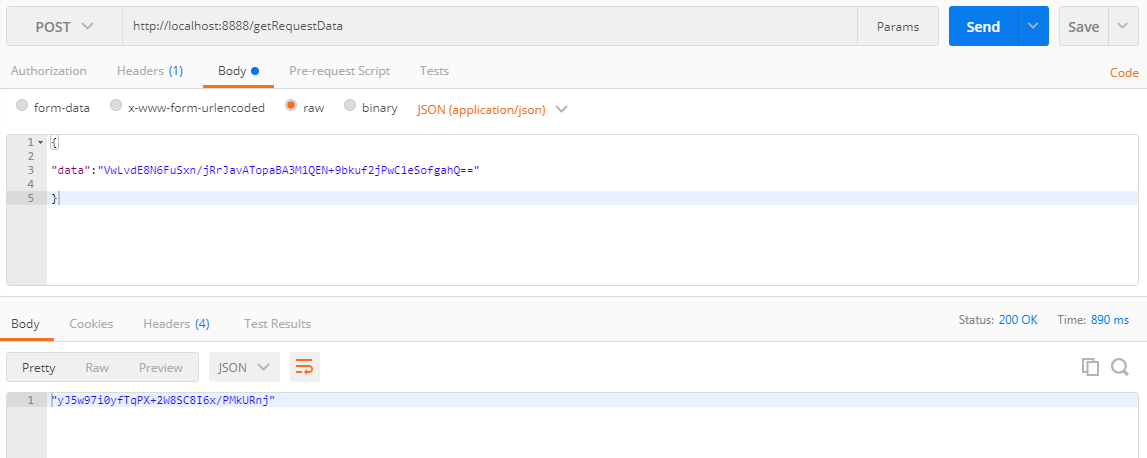SpringBoot实现接口数据的加解密功能
一、加密方案介绍
对接口的加密解密操作主要有下面两种方式:
自定义消息转换器
优势:仅需实现接口,配置简单。
劣势:仅能对同一类型的MediaType进行加解密操作,不灵活。
使用spring提供的接口RequestBodyAdvice和ResponseBodyAdvice
优势:可以按照请求的Referrer、Header或url进行判断,按照特定需要进行加密解密。
比如在一个项目升级的时候,新开发功能的接口需要加解密,老功能模块走之前的逻辑不加密,这时候就只能选择上面的第二种方式了,下面主要介绍下第二种方式加密、解密的过程。
二、实现原理
RequestBodyAdvice可以理解为在@RequestBody之前需要进行的 操作,ResponseBodyAdvice可以理解为在@ResponseBody之后进行的操作,所以当接口需要加解密时,在使用@RequestBody接收前台参数之前可以先在RequestBodyAdvice的实现类中进行参数的解密,当操作结束需要返回数据时,可以在@ResponseBody之后进入ResponseBodyAdvice的实现类中进行参数的加密。
RequestBodyAdvice处理请求的过程:
RequestBodyAdvice源码如下:
public interface RequestBodyAdvice {
boolean supports(MethodParameter methodParameter, Type targetType,
Class<? extends HttpMessageConverter<?>> converterType);
HttpInputMessage beforeBodyRead(HttpInputMessage inputMessage, MethodParameter parameter,
Type targetType, Class<? extends HttpMessageConverter<?>> converterType) throws IOException;
Object afterBodyRead(Object body, HttpInputMessage inputMessage, MethodParameter parameter,
Type targetType, Class<? extends HttpMessageConverter<?>> converterType);
@Nullable
Object handleEmptyBody(@Nullable Object body, HttpInputMessage inputMessage, MethodParameter parameter,
Type targetType, Class<? extends HttpMessageConverter<?>> converterType);
}
调用RequestBodyAdvice实现类的部分代码如下:
protected <T> Object readWithMessageConverters(HttpInputMessage inputMessage, MethodParameter parameter,
Type targetType) throws IOException, HttpMediaTypeNotSupportedException, HttpMessageNotReadableException {
MediaType contentType;
boolean noContentType = false;
try {
contentType = inputMessage.getHeaders().getContentType();
}
catch (InvalidMediaTypeException ex) {
throw new HttpMediaTypeNotSupportedException(ex.getMessage());
}
if (contentType == null) {
noContentType = true;
contentType = MediaType.APPLICATION_OCTET_STREAM;
}
Class<?> contextClass = parameter.getContainingClass();
Class<T> targetClass = (targetType instanceof Class ? (Class<T>) targetType : null);
if (targetClass == null) {
ResolvableType resolvableType = ResolvableType.forMethodParameter(parameter);
targetClass = (Class<T>) resolvableType.resolve();
}
HttpMethod httpMethod = (inputMessage instanceof HttpRequest ? ((HttpRequest) inputMessage).getMethod() : null);
Object body = NO_VALUE;
EmptyBodyCheckingHttpInputMessage message;
try {
message = new EmptyBodyCheckingHttpInputMessage(inputMessage);
for (HttpMessageConverter<?> converter : this.messageConverters) {
Class<HttpMessageConverter<?>> converterType = (Class<HttpMessageConverter<?>>) converter.getClass();
GenericHttpMessageConverter<?> genericConverter =
(converter instanceof GenericHttpMessageConverter ? (GenericHttpMessageConverter<?>) converter : null);
if (genericConverter != null ? genericConverter.canRead(targetType, contextClass, contentType) :
(targetClass != null && converter.canRead(targetClass, contentType))) {
if (logger.isDebugEnabled()) {
logger.debug("Read [" + targetType + "] as \"" + contentType + "\" with [" + converter + "]");
}
if (message.hasBody()) {
HttpInputMessage msgToUse =
getAdvice().beforeBodyRead(message, parameter, targetType, converterType);
body = (genericConverter != null ? genericConverter.read(targetType, contextClass, msgToUse) :
((HttpMessageConverter<T>) converter).read(targetClass, msgToUse));
body = getAdvice().afterBodyRead(body, msgToUse, parameter, targetType, converterType);
}
else {
body = getAdvice().handleEmptyBody(null, message, parameter, targetType, converterType);
}
break;
}
}
}
catch (IOException ex) {
throw new HttpMessageNotReadableException("I/O error while reading input message", ex);
}
if (body == NO_VALUE) {
if (httpMethod == null || !SUPPORTED_METHODS.contains(httpMethod) ||
(noContentType && !message.hasBody())) {
return null;
}
throw new HttpMediaTypeNotSupportedException(contentType, this.allSupportedMediaTypes);
}
return body;
}
从上面源码可以到当converter.canRead()和message.hasBody()都为true的时候,会调用beforeBodyRead()和afterBodyRead()方法,所以我们在实现类的afterBodyRead()中添加解密代码即可。
ResponseBodyAdvice处理响应的过程:
ResponseBodyAdvice源码如下:
public interface ResponseBodyAdvice<T> {
boolean supports(MethodParameter returnType, Class<? extends HttpMessageConverter<?>> converterType);
@Nullable
T beforeBodyWrite(@Nullable T body, MethodParameter returnType, MediaType selectedContentType,
Class<? extends HttpMessageConverter<?>> selectedConverterType,
ServerHttpRequest request, ServerHttpResponse response);
}
调用ResponseBodyAdvice实现类的部分代码如下:
if (selectedMediaType != null) {
selectedMediaType = selectedMediaType.removeQualityValue();
for (HttpMessageConverter<?> converter : this.messageConverters) {
GenericHttpMessageConverter genericConverter =
(converter instanceof GenericHttpMessageConverter ? (GenericHttpMessageConverter<?>) converter : null);
if (genericConverter != null ?
((GenericHttpMessageConverter) converter).canWrite(declaredType, valueType, selectedMediaType) :
converter.canWrite(valueType, selectedMediaType)) {
outputValue = (T) getAdvice().beforeBodyWrite(outputValue, returnType, selectedMediaType,
(Class<? extends HttpMessageConverter<?>>) converter.getClass(),
inputMessage, outputMessage);
if (outputValue != null) {
addContentDispositionHeader(inputMessage, outputMessage);
if (genericConverter != null) {
genericConverter.write(outputValue, declaredType, selectedMediaType, outputMessage);
}
else {
((HttpMessageConverter) converter).write(outputValue, selectedMediaType, outputMessage);
}
if (logger.isDebugEnabled()) {
logger.debug("Written [" + outputValue + "] as \"" + selectedMediaType +
"\" using [" + converter + "]");
}
}
return;
}
}
}
从上面源码可以到当converter.canWrite()为true的时候,会调用beforeBodyWrite()方法,所以我们在实现类的beforeBodyWrite()中添加解密代码即可。
三、实战
新建一个spring boot项目spring-boot-encry,按照下面步骤操作。
pom.xml中引入jar
<dependencies>
<dependency>
<groupId>org.springframework.boot</groupId>
<artifactId>spring-boot-starter-web</artifactId>
</dependency>
<dependency>
<groupId>org.projectlombok</groupId>
<artifactId>lombok</artifactId>
<optional>true</optional>
</dependency>
<dependency>
<groupId>org.springframework.boot</groupId>
<artifactId>spring-boot-starter-test</artifactId>
<scope>test</scope>
<exclusions>
<exclusion>
<groupId>org.junit.vintage</groupId>
<artifactId>junit-vintage-engine</artifactId>
</exclusion>
</exclusions>
</dependency>
<dependency>
<groupId>com.alibaba</groupId>
<artifactId>fastjson</artifactId>
<version>1.2.60</version>
</dependency>
</dependencies>
请求参数解密拦截类
DecryptRequestBodyAdvice代码如下:
/**
* 请求参数 解密操作
* * @Author: Java碎碎念
* @Date: 2019/10/24 21:31
*
*/
@Component
@ControllerAdvice(basePackages = "com.example.springbootencry.controller")
@Slf4j
public class DecryptRequestBodyAdvice implements RequestBodyAdvice {
@Override
public boolean supports(MethodParameter methodParameter, Type targetType, Class<? extends HttpMessageConverter<?>> converterType) {
return true;
}
@Override
public HttpInputMessage beforeBodyRead(HttpInputMessage inputMessage, MethodParameter methodParameter, Type targetType, Class<? extends HttpMessageConverter<?>> selectedConverterType) throws IOException {
return inputMessage;
}
@Override
public Object afterBodyRead(Object body, HttpInputMessage inputMessage, MethodParameter parameter, Type targetType, Class<? extends HttpMessageConverter<?>> converterType) {
String dealData = null;
try {
//解密操作
Map<String,String> dataMap = (Map)body;
String srcData = dataMap.get("data");
dealData = DesUtil.decrypt(srcData);
} catch (Exception e) {
log.error("异常!", e);
}
return dealData;
}
@Override
public Object handleEmptyBody(@Nullable Object var1, HttpInputMessage var2, MethodParameter var3, Type var4, Class<? extends HttpMessageConverter<?>> var5) {
log.info("3333");
return var1;
}
}
响应参数加密拦截类
EncryResponseBodyAdvice代码如下:
/**
* 请求参数 解密操作
*
* @Author: Java碎碎念
* @Date: 2019/10/24 21:31
*
*/
@Component
@ControllerAdvice(basePackages = "com.example.springbootencry.controller")
@Slf4j
public class EncryResponseBodyAdvice implements ResponseBodyAdvice<Object> {
@Override
public boolean supports(MethodParameter returnType, Class<? extends HttpMessageConverter<?>> converterType) {
return true;
}
@Override
public Object beforeBodyWrite(Object obj, MethodParameter returnType, MediaType selectedContentType,
Class<? extends HttpMessageConverter<?>> selectedConverterType, ServerHttpRequest serverHttpRequest,
ServerHttpResponse serverHttpResponse) {
//通过 ServerHttpRequest的实现类ServletServerHttpRequest 获得HttpServletRequest
ServletServerHttpRequest sshr = (ServletServerHttpRequest) serverHttpRequest;
//此处获取到request 是为了取到在拦截器里面设置的一个对象 是我项目需要,可以忽略
HttpServletRequest request = sshr.getServletRequest();
String returnStr = "";
try {
//添加encry header,告诉前端数据已加密
serverHttpResponse.getHeaders().add("encry", "true");
String srcData = JSON.toJSONString(obj);
//加密
returnStr = DesUtil.encrypt(srcData);
log.info("接口={},原始数据={},加密后数据={}", request.getRequestURI(), srcData, returnStr);
} catch (Exception e) {
log.error("异常!", e);
}
return returnStr;
}
新建controller类
TestController代码如下:
/** * @Author: Java碎碎念
* @Date: 2019/10/24 21:40
*/
@RestController
public class TestController {
Logger log = LoggerFactory.getLogger(getClass());
/**
* 响应数据 加密
*/
@RequestMapping(value = "/sendResponseEncryData")
public Result sendResponseEncryData() {
Result result = Result.createResult().setSuccess(true);
result.setDataValue("name", "Java碎碎念");
result.setDataValue("encry", true);
return result;
}
/**
* 获取 解密后的 请求参数
*/
@RequestMapping(value = "/getRequestData")
public Result getRequestData(@RequestBody Object object) {
log.info("controller接收的参数object={}", object.toString());
Result result = Result.createResult().setSuccess(true);
return result;
}
}
其他类在源码中,后面有github地址
四、测试
访问响应数据加密接口
使用postman发请求http://localhost:8888/sendResponseEncryData,可以看到返回数据已加密,请求截图如下:

响应数据加密截图
后台也打印相关的日志,内容如下:
接口=/sendResponseEncryData
原始数据={"data":{"encry":true,"name":"Java碎碎念"},"success":true}
加密后数据=vJc26g3SQRU9gAJdG7rhnAx6Ky/IhgioAgdwi6aLMMtyynAB4nEbMxvDsKEPNIa5bQaT7ZAImAL7
3VeicCuSTA==
访问请求数据解密接口
使用postman发请求http://localhost:8888/getRequestData,可以看到请求数据已解密,请求截图如下:

请求数据解密截图
后台也打印相关的日志,内容如下:
接收到原始请求数据={"data":"VwLvdE8N6FuSxn/jRrJavATopaBA3M1QEN+9bkuf2jPwC1eSofgahQ=="}
解密后数据={"name":"Java碎碎念","des":"请求参数"}
五、踩到的坑
测试解密请求参数时候,请求体一定要有数据,否则不会调用实现类触发解密操作。
到此SpringBoot中如何灵活的实现接口数据的加解密功能的功能已经全部实现,有问题欢迎留言沟通哦!
完整源码地址: https://github.com/suisui2019/springboot-study
总结
以上所述是小编给大家介绍的SpringBoot实现接口数据的加解密功能,希望对大家有所帮助,如果大家有任何疑问请给我留言,小编会及时回复大家的。在此也非常感谢大家对我们网站的支持!
如果你觉得本文对你有帮助,欢迎转载,烦请注明出处,谢谢!

